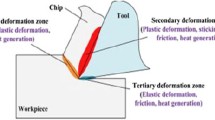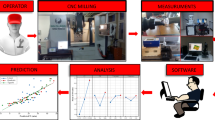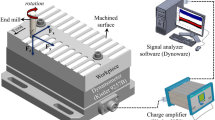Abstract
Ceramic materials have become one of the ideal materials for manufacturing cutting tools in the field of high-speed machining due to their excellent heat resistance, wear resistance, and high temperature strength. Aiming at the difficult-to-machine characteristics of nickel-based superalloy, such as high strength and toughness, low thermal conductivity, and strong viscosity, the cutting performance of four self-developed silicon ceramic end mills defining as S1, S2, S3, and S4 in machining of GH4099 was compared and studied in this work. The cutting force, tool life, cutting temperature, and machined surface roughness were deeply evaluated. The results indicate that the tool life of our developed ceramic tools was 14 times higher than commercial carbide tool at the cutting speed of 400 m/min, and furthermore, their maximum metal removal rate of the ceramic tool could reach 8.15 cm3/min. Besides, the average cutting efficiency of the ceramic tool can be 1.5 times higher than carbide tool in our investigation. It was worth noting that not only the cutting force of the ceramic tool was 13.5% lower but also the machined surface roughness was slightly lower than carbide tool. The wear mechanisms of the ceramic end mills were mainly adhesive wear and diffusion wear. In general, the four self-developed silicon ceramic end milling tools exhibited better cutting performance than carbide tool.














Similar content being viewed by others
Data availability
All data generated or analyzed during this study are included in this published article.
References
Thakur A, Gangopadhyay S (2016) State-of-the-art in surface integrity in machining of nickel-based super alloys. Int J Mach Tools Manuf 100:25–54. https://doi.org/10.1016/j.ijmachtools.2015.10.001
Zou B, Chen M, Huang CZ, An QL (2009) Study on surface damages caused by turning NiCr20TiAl nickel-based alloy. J Mater Process Technol 209:5802–5809. https://doi.org/10.1016/j.jmatprotec.2009.06.017
Ulutan D, Ozel T (2011) Machining induced surface integrity in titanium and nickel alloys: a review. Int J Mach Tool Manuf 51:250–280. https://doi.org/10.1016/j.ijmachtools.2010.11.003
Pervaiz S, Rashid A, Deiab I, Nicolescu M (2014) Influence of tool materials on machinability of titanium-and nickel-based alloys: a review. Mater Manuf Processes 29:219–252. https://doi.org/10.1080/10426914.2014.880460
Li YS, Zou B, Shi ZY, Huang CZ, Li L, Liu HL, Zhu HT, Yao P, Liu JK (2021) Wear patterns and mechanisms of sialon ceramic end-milling tool during high speed machining of nickel-based superalloy. Ceram Int 47:2690–5698. https://doi.org/10.1016/j.ceramint.2020.10.155
Richards N, Aspinwall D (1989) Use of ceramic tools for machining nickel based alloys. Int J Mach Tools Manuf 29:575–588. https://doi.org/10.1016/0890-6955(89)90072-2
Cai XJ, Qin S, An QL, Chen M (2012) Experimental investigation on surface integrity of end milling nickel based alloy-Inconel 718. Mach Sci Technol 500:51–57. https://doi.org/10.4028/www.scientific.net/AMR.500.51
Dudzinski D, Deville A, Moufki A, Larrouquère D, Zerrouki V, Vigneau J (2004) A review of developments towards dry and high speed machining of Inconel 718 alloy. Int J Mach Tools Manuf 44:439–456. https://doi.org/10.1016/S0890-6955(03)00159-7
Zhao C, Shi YY, Qi M, Wang ZB, Xi W (2014) Studies on ceramic cutting tool wear for the high speed milling nickel-based superalloy. N/A 800–801:501–505. https://doi.org/10.4028/www.scientific.net/MSF.800-801.501
Liu W, Chu Q, Zeng J, He RX, Wu HD, Wu ZW, Wu SH (2017) PVD-CrAlN and TiAlN coated Si3N4 ceramic cutting inserts-2. High speed face milling performance and wear mechanism study. Ceram Int 43:9488–9492. https://doi.org/10.1016/j.ceramint.2017.04.127
Kitagawa T, Kubo A, Maekawa K (1997) Temperature and wear of cutting tools in high-speed machining of Inconel 718 and Ti-6Al-6V-2Sn. Wear 202:142–148. https://doi.org/10.1016/S0043-1648(96)07255-9
Zhao JF, Liu ZQ, Wang B, Hu JR, Wan Y (2021) Tool coating effects on cutting temperature during metal cutting processes: comprehensive review and future research directions. Mech Syst Signal Proc 150:107302. https://doi.org/10.1016/j.ymssp.2020.107302
Zhu DH, Zhang XM, Ding H (2013) Tool wear characteristics in machining of nickel-based superalloys. Int J Mach Tool Manuf 64:60–77. https://doi.org/10.1016/j.ijmachtools.2012.08.001
Xing HY, Zou B, Liu XY, Wang XF, Chen QH, Fu XS, Li YS (2020) Effect of particle size distribution on the preparation of ZTA ceramic paste applying for stereolithography 3D printing. Powder Technol 359:314–322. https://doi.org/10.1016/j.powtec.2019.09.066
Liu XY, Zou B, Xing HY, Huang CZ (2020) The preparation of ZrO2-Al2O3 composite ceramic by SLA-3D printing and sintering processing. Ceram Int 46:937–944. https://doi.org/10.1016/j.ceramint.2019.09.054
Zheng GM, Zhao J, Zhou YH (2012) Friction and wear behaviors of Sialon–Si3N4 graded nano-composite ceramic materials in sliding wear tests and in cutting processes. Wear 290:41–50. https://doi.org/10.1016/j.wear.2012.05.020
Çelik A (2018) Dopant-dependent diffusion behavior of Sialon ceramics against Inconel718 superalloy. Ceram Int 44:17440–17446. https://doi.org/10.1016/j.ceramint.2018.06.211
Finkeldei D, Sexauer M, Bleicher F (2019) End milling of Inconel 718 using solid Si3N4 ceramic cutting tools. Procedia CIRP 81:1131–1135. https://doi.org/10.1016/j.procir.2019.03.280
Wang B, Liu ZQ (2016) Cutting performance of solid ceramic end milling tools in machining hardened AISI H13 steel. Int J Refract Met Hard Mater 55:24–32. https://doi.org/10.1016/j.ijrmhm.2015.11.004
Zhang H, Dang JQ, Ming WW, Xu XW, Chen M, An QL (2020) Cutting responses of additive manufactured Ti6Al4V with solid ceramic tool under dry high-speed milling processes. Ceram Int 46:14536–14547. https://doi.org/10.1016/j.ceramint.2020.02.253
Molaiekiya F, Aramesh M, Veldhuis SC (2020) Chip formation and tribological behavior in high-speed milling of IN718 with ceramic tools. Wear 446:20319. https://doi.org/10.1016/j.wear.2020.203191
Tian XH, Zhao J, Zhao JB, Gong ZC, Dong Y (2013) Effect of cutting speed on cutting forces and wear mechanisms in high-speed face milling of Inconel 718 with Sialon ceramic tools. Int J Adv Manuf Technol 69:2669–2678. https://doi.org/10.1007/s00170-013-5206-4
Sun JF, Huang S, Ding HT, Chen WY (2020) Cutting performance and wear mechanism of Sialon ceramic tools in high speed face milling GH4099. Ceram Int 46:1621–1630. https://doi.org/10.1016/j.ceramint.2019.09.134
Wang YS, Zou B, Wang JC, Wu Y, Huang CZ (2020) Effect of the progressive tool wear on surface topography and chip formation in micro-milling of Ti–6Al–4V using Ti (C7N3)-based cermet micro-mill. Tribol Int 141:105900. https://doi.org/10.1016/j.triboint.2019.105900
Wang YS, Zou B, Huang CZ, Qi H, Song JP (2019) Feasibility study of the Ti(C7N3)-based cermet micro-mill based on dynamic fatigue behavior and modeling of the contact stress distribution on the round cutting edge. Int J Mech Sci 155:143–158. https://doi.org/10.1016/j.ijmecsci.2019.02.038
Vagnorius Z, Sorby K (2011) Effect of high-pressure cooling on life of SiAlON tools in machining of Inconel 718. Int J Adv Manuf Technol 54:83–92. https://doi.org/10.1007/s00170-010-2944-4
Sivalingam V, Zan ZL, Sun J, Selvam B, Gupta MK, Jamil M, Mia M (2020) Wear behaviour of whisker-reinforced ceramic tools in the turning of Inconel 718 assisted by an atomized spray of solid lubricants. Tribol Int 148:106235. https://doi.org/10.1016/j.triboint.2020.106235
Bhattacharyya P, Sengupta D, Mukhopadhyay S (2007) Cutting force-based real-time estimation of tool wear in face milling using a combination of signal processing techniques. Mech Syst Signal Process 21:2665–2683. https://doi.org/10.1016/j.ymssp.2007.01.004
Rani DA, Yoshizawa Y, Hyuga H, Hirao K, Yamauchi Y (2004) Tribological behavior of ceramic materials (Si3N4, SiC and Al2O3) in aqueous medium. J Eur Ceram Soc 24:3279–3284. https://doi.org/10.1016/j.jeurceramsoc.2003.11.020
Huang XH, Zou F, Ming WW, Xu JY, Chen Y, Chen M (2020) Wear mechanisms and effects of monolithic Sialon ceramic tools in side milling of superalloy FGH96. Ceram Int 46:26813–26822. https://doi.org/10.1016/j.ceramint.2020.07.157
Nie LF, Zhang LW, Zhu Z, Xu W (2013) Constitutive modeling of dynamic recrystallization kinetics and processing maps of solution and aging FGH96 superalloy. J Mater Eng Perform 22:3728–3734. https://doi.org/10.1007/s11665-013-0699-4
Wang YS, Zou B, Huang CZ (2019) Tool wear mechanisms and micro-channels quality in micro-machining of Ti-6Al-4V alloy using the Ti(C7N3)-based cermet micro-mills. Tribol Int 134:60–76. https://doi.org/10.1016/j.triboint.2019.01.030
Chen MJ, Ni HB, Wang ZJ, Jiang Y (2012) Research on the modeling of burr formation process in micro-ball end milling operation on Ti–6Al–4V. Int J Adv Manuf Technol 62:901–912. https://doi.org/10.1007/s00170-011-3865-6
Ming WW, Huang XH, Xu JY, Zou F, Chen M (2021) Analysis of cutting responses of Sialon ceramic tools in high-speed milling of FGH96 superalloys. Ceram Int 47:149–156. https://doi.org/10.1016/j.ceramint.2020.08.118
Devillez A, Schneider F, Dominiak S, Dudzinski D (2007) Cutting forces and wear in dry machining of Inconel 718 with coated carbide tools. Wear 262:931–942. https://doi.org/10.1016/j.wear.2006.10.009
Bushlya V, Zhou JM, Avdovic P, Stahl JE (2013) Wear mechanisms of silicon carbide-whisker-reinforced alumina (Al2O3-SiCw) cutting tools when high-speed machining aged Alloy 718. Int J Adv Manuf Technol 68:1083–1093. https://doi.org/10.1007/s00170-013-4899-8
Çelik A, Alagaç MS, Turan S, Kara A, Kara F (2017) Wear behavior of solid SiAlON milling tools during high speed milling of Inconel 718. Wear 378:58–67. https://doi.org/10.1016/j.wear.2017.02.025
Funding
This research effort was supported by the National Natural Science Foundation of China (51875319) and Shandong Natural Science Foundation of China (ZR2020ZD05).
Author information
Authors and Affiliations
Contributions
Hewu Sun (first author): conceptualization, methodology, validation, formal analysis, investigation, writing original draft. Bin Zou (corresponding author): conceptualization, formal analysis, resources, writing—review and editing. Wei Chen: Formal analysis. The authors’ contributions correspond their order. All authors read and approved the final manuscript.
Corresponding author
Ethics declarations
Conflicts of interest
The authors declare no competing interests.
Ethics approval
No conflict of interest exits in the submission of this manuscript, and the manuscript is approved by all authors for publication. This study does not involve human participants and/or animal studies. I would like to declare on behalf of my co-authors that the work described was original research that has not been published previously, and not under consideration for publication elsewhere, in whole or in part. All the authors listed have approved the manuscript that is enclosed.
Additional information
Publisher's Note
Springer Nature remains neutral with regard to jurisdictional claims in published maps and institutional affiliations.
Rights and permissions
About this article
Cite this article
Sun, H., Zou, B. & Chen, W. Cutting performance of silicon-based ceramic end milling tools in high-efficiency machining of GH4099 under dry condition. Int J Adv Manuf Technol 118, 1719–1732 (2022). https://doi.org/10.1007/s00170-021-08084-1
Received:
Accepted:
Published:
Issue Date:
DOI: https://doi.org/10.1007/s00170-021-08084-1




